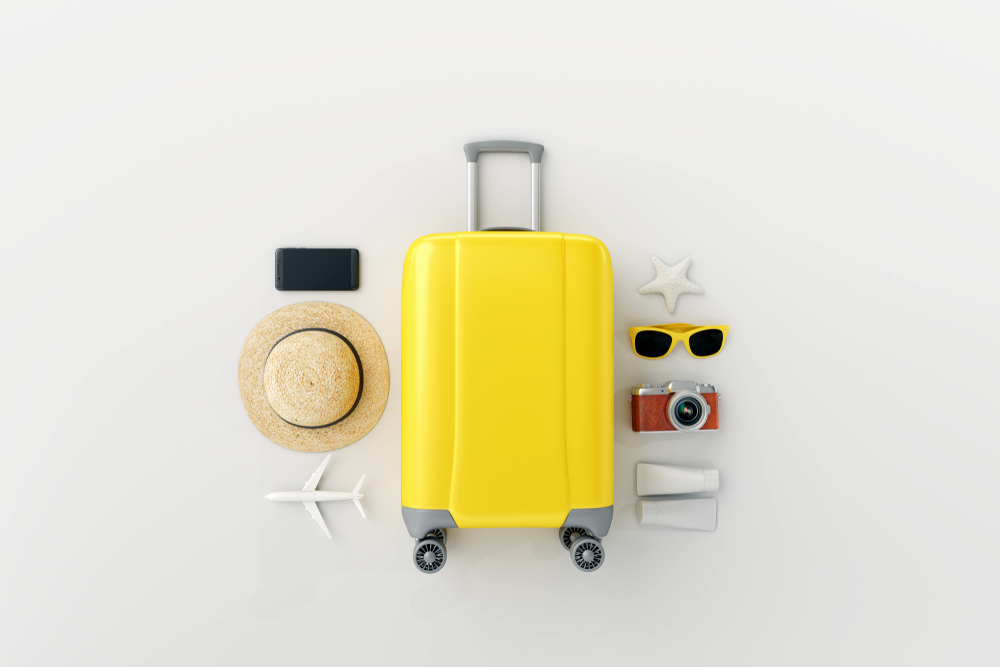It is not so easy to find the perfect case, because other cases are correspondingly more recommended for different areas of use. Of course, it also depends on your personal taste, after all, a suitcase should not only be durable, but also look good and be clearly visible on the conveyor belt at the airport.
In the following, we would like to help you with five tips to narrow down the offer and to be able to find the best suitcase quickly, regardless of its appearance.
-
The right volume
Before you just blindly buy a suitcase, we recommend that you put all your travel utensils, clothes and accessories together and pack them as compactly as possible on one surface. This allows you to measure the minimum volume you need quite easily – albeit without additional pressure.
Of course, how big a suitcase should be also depends on your usual travel time. Typically, suitcases for a weekend trip have a volume of between 20 and 40 liters. Suitcases for a one-week trip, on the other hand, should already have a volume of about 50 to 70 liters. For longer trips of 10 days or more, we recommend a suitcase with a capacity of 70 to 90 litres. Very large XXL suitcases are also available with a volume of up to 140 litres. Such models are then also suitable for three- or four-week trips.
-
Listen to experience and tests
Since new models are constantly coming onto the market, it is practically impossible to keep track of them. Therefore, it is advisable to find out about current models and recommendations via comparison portals such as https://10toptest.de . Reviews from other buyers can also help to distinguish a bad suitcase from a good one. You should not be guided solely by product photos, because you can hardly see the quality, workmanship and handling.
-
Hard shell, soft core

When it comes to suitcases, a distinction is made between hard-shell suitcases and softshell suitcases, i.e. suitcases with a soft shell. The latter are much more flexible, softer and can be deformed a bit, which is interesting if you want to store them frequently in the trunk. In addition, they can stretch outwards, so that a little more fits in than is actually indicated.
Hard-shell cases, on the other hand, are much more solid, the contents are usually better protected from water and they are often more solid, especially if wheels are installed, which can simply be fixed better to the hard-shell case. Sensitive clothing that wrinkles easily can be transported much better in a hard-shell suitcase and sensitive objects are also better protected here. Hard-shell suitcases are usually made of a combination of polycarbonate and/or ABS. Prolypropylene or aluminum are also common. Soft-shell suitcases, on the other hand, are made of flexible materials such as polyester, nylon or leather.
-
Trolley, travel bag or suitcase?
Most suitcases sold today are trolleys because they have wheels, making them easier to move around without having to carry them all the time. However, you should always pay attention to high-quality wheels, because they can be a weak point in cheap suitcases.
Compared to trolleys, you have to carry travel bags all the time and you can’t use them as a seat, which can be quite handy for a suitcase when you’re standing in a queue. Classic hard-shell suitcases without wheels are now becoming less and less common, as they can neither be wheeled nor carried with a shoulder strap. With trolleys, you can pull out a telescopic handle and pull the suitcase or bag comfortably behind you. The big advantage of a travel bag is certainly that you can also use it as a sports bag or for other purposes, for example.
-
The maximum weight of the airlines
Especially if you want to take the suitcase with you on air travel, you should consider how much extra weight you can take with you without additional fees before buying. Especially with large hard-shell suitcases, the dead weight of the suitcase also plays a major role.
Lightweight wide-shell suitcases allow you to take significantly more clothing and other things with you before you reach the maximum weight. Most airlines allow an additional 20 kilograms of weight for checked baggage. On cheap flights, on the other hand, you are often not allowed to check in baggage at all without paying a surcharge. In these cases, it may be advisable to look at the maximum dimensions of hand luggage. However, only very small suitcases will fall within the maximum size of the carry-on bag.


